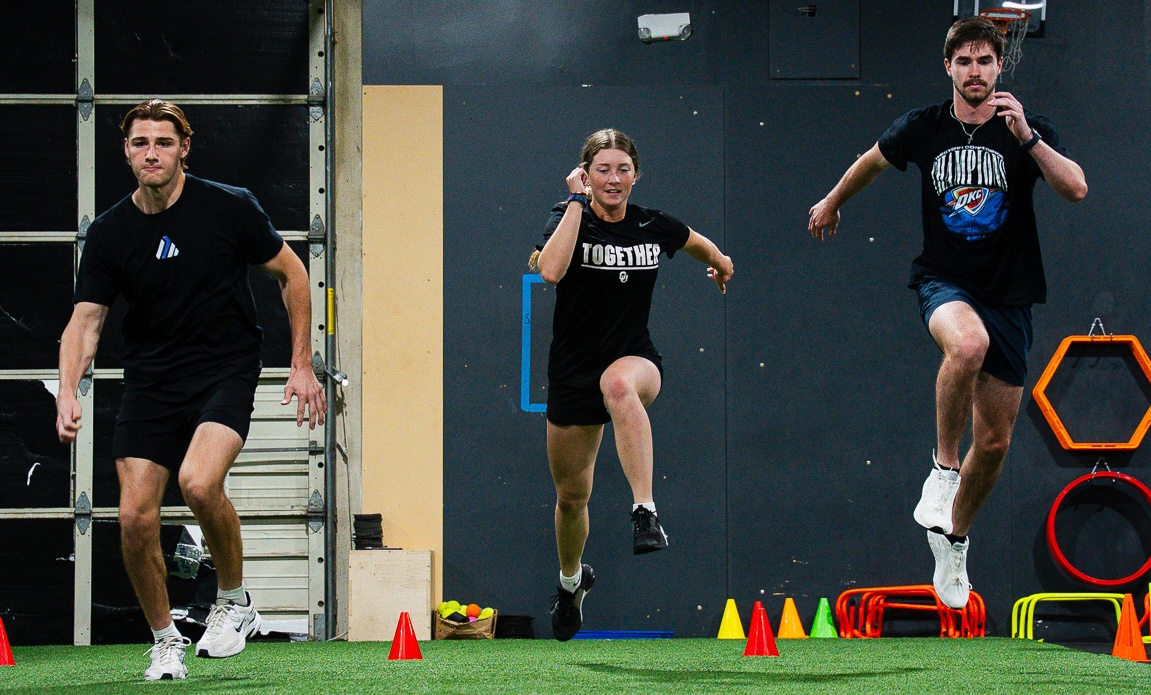Plyometric Movements
ESTABLISHED 2020
Plyometric Movements for Explosiveness at Next Level Athletics
At Next Level Athletics, plyometric movements are a core component of our athlete performance programs. These high-velocity, reactive exercises are designed to train the stretch-shortening cycle (SSC) of the muscles by keeping ground contact time at or below 0.2 seconds. This fast-loading, fast-releasing muscle action is what powers elite athletic movements — like explosive sprints, vertical jumps, and quick changes of direction. Plyometric training has been scientifically proven to increase vertical power, reactive strength, and sport-specific explosiveness (Rafael L. Kons, Effects of Plyometric Training in Physical Performance).
Unlike standard jump training, true plyometrics demand quick transitions between eccentric and concentric phases. This rapid muscle action trains the neuromuscular system to produce more force, more quickly, without relying on heavy external loads. At Next Level, every plyometric movement is carefully selected based on Next Level’s Athlete Assessment data, sport demands, and athlete readiness — making our programming both safe and effective for long-term athletic development.
Why Plyometric Movements Matter
Plyometric movements are backed by research showing improvements in rate of force development (RFD) — the speed at which an athlete can generate explosive power. Whether you’re taking your first step out of a sprint stance, contesting a rebound, or reacting to a cut on the field, your ability to load and explode rapidly can be the difference between average and elite performance.
Beyond pure vertical jump gains, plyometrics improve joint stability, core control, and movement efficiency — essential qualities for staying injury-resistant and performing consistently at a high level. When taught and progressed correctly, these movements lead to measurable improvements in sprint speed, jump height, and reactive agility.
At Next Level Athletics, our coaches focus on key mechanics such as posture, ground stiffness, and safe landings, ensuring athletes get the most out of their training while staying confident and injury-free.
What Makes Our Plyometric Training Different
Our plyometric programming emphasizes true explosiveness, focusing not just on how high or far an athlete can jump, but how quickly they can rebound off the ground. Every drill is chosen to enhance neuromuscular responsiveness, elastic energy return, and movement specificity for sport.
Here are a few examples of movements we implement:
• Depth Jump to Vertical Jump – Builds reactive strength with minimal ground contact
• Mini Hurdle Hops – Improves rhythm, stiffness, and reactive bounce for sprint transfer
• Pogo Hops and Ankle Bounces – Strengthens foot and ankle reactivity for sustained high-volume training
• Lateral Reactive Bounds – Develops side-to-side explosiveness and control under pressure
• Single-Leg Tuck Jumps – Increases unilateral coordination, joint integrity, and takeoff speed
Every movement is scaled to the athlete’s age, ability, and competitive level. Youth athletes focus on movement quality and coordination, while advanced athletes train through complex high-velocity plyo circuits designed to mimic game-time intensity.
Plyometric Movements + Assessment-Based Training
All of our explosive training begins with Next Level’s Athlete Assessment — a six-test performance evaluation used to identify current ability in force production, vertical jump power, speed, and agility. If an athlete shows low RFD, delayed reaction time, or inconsistent landing control, we build their program around targeted plyometric interventions to correct those gaps.
We offer monthly Assessment Days to track athlete improvement in key areas like standing vertical, broad jump, and 20-yard sprint time. This regular testing ensures our programming evolves with each athlete and keeps motivation high by celebrating real progress.
The Next Level Standard
What sets our plyometric training apart is how we coach, cue, and progress each exercise. We don’t run cookie-cutter drills or fill workouts with fluff — every jump, rebound, and rep is purpose-driven and built into a long-term development plan. We focus on quality over quantity, helping athletes sharpen their movement patterns for real-world application in sport.
Training at Next Level Athletics means being surrounded by passionate coaches, competitive peers, and an environment designed to bring out the best in you. When plyometric training is combined with strength, speed, and recovery work, it becomes one of the most powerful tools for developing next-level athletes.
Ready to Explode Off the Ground?
If you’re serious about improving your vertical jump, first-step quickness, or on-field reactivity, it starts with mastering the science of plyometric movements. Sign up for a free athlete performance class, meet our expert coaches, and experience how structured, explosive training turns inches into game-changing moments.
Curious what sort of plyometric movements we do?
Plyometric movements are dynamic, high-intensity exercises designed to build explosive power, speed, and reactive strength. At Next Level Athletics, we use these movements to help athletes increase vertical jump, improve first-step quickness, and move more efficiently in real game situations. Plyometric training focuses on rapid force production, body control, and multi-directional movement, making it one of the most effective tools for improving performance across all sports. By developing an athlete’s ability to explode, absorb, and redirect force, we build stronger, faster, and more resilient athletes — not just in training, but where it matters most: on the field or court.
POGOS

BOUNDING

LATERAL HOPS

